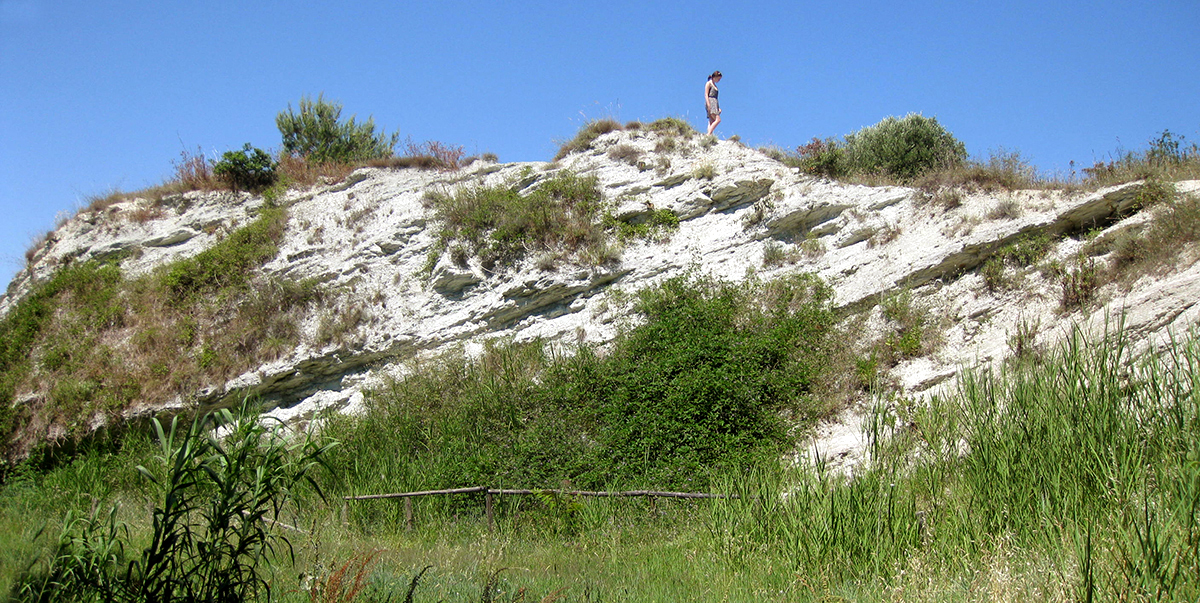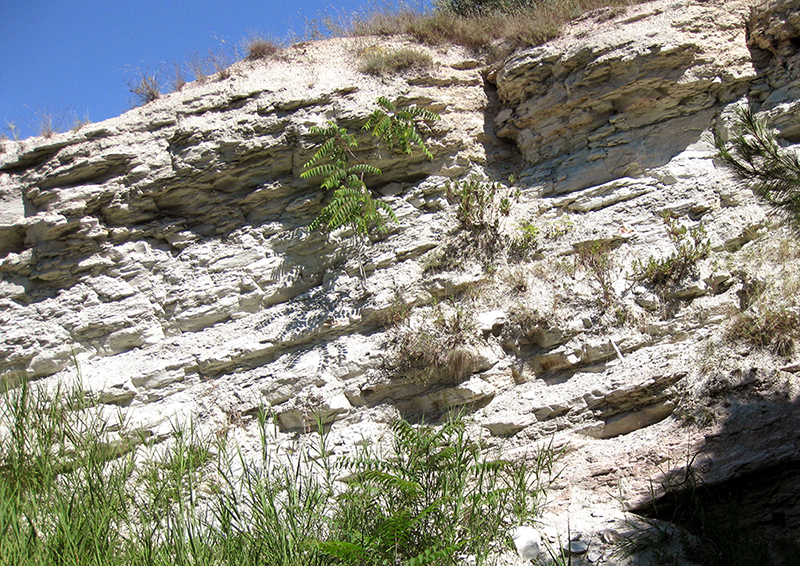GSSP for Rupelian Stage (Oligocene)
Description:
The GSSP for the base of the Rupelian Stage (Eocene/Oligocene boundary) is defined in the Massignano section about 10 km southeast of Ancona, Italy. The GSSP is at the base of a 0.5 m thick greenish-grey marl bed. At this level, both the planktonic foraminifera Hantkenina and Cribrohantkenina, Eocene genera of the Hantkeninidae, become extinct.
Primary markers:
The planktonic foraminifera Hantkenina and Cribrohantkenina, Eocene genera of the Hantkeninidae, become extinct at the GSSP.

Location: The Massignano Section is located on the Adriatic coast of Italy near Ancona in the Monte Conero area. It is an abandoned quarry on the east side of the Ancona-Sirolo road near the village of Massignano. The section is located at latitude 43°32’13”N and longitude 13°35’36”E (Geolical Map of Italy: F. 118, Ancona). The GSSP is situated at 19 m above the base of the section.
Sedimentology: The Massignano section, which covers the late Eocene to Early Oligocene, is 23 m thick and consists of reddish and greenish grey marls and calcareous marls. The lower part is in the Scaglia Variegata Formation (12.3 m) and above this is the Scaglia Cinera Formation (10.7 m). The sediments of the Massignano section are completely marine with no evidence of any hiatus. The GSSP is at the base of a greenish-grey 0.5 m thick marl bed, 19 m above the base of the section.
Secondary Markers:
Nannofossils: The GSSP is within calcareous nannofossil zones NP21 and CP16a.
Paleomagnetics: The Massignano section lies within magnetic polarity reversal 13R1.
Radiometric Age: Radiometric ages (K-Ar and 40Ar-39Ar) have been obtained from biotites. The date of 34.6+0.3Ma at 14.7 m above the base of the section indicates that the age of the GSSP at 19 m is younger and is estimated to be 34 Ma.
The Massignano section holds one of the world’s best records of the enigmatic extraterrestrial events in the Late Eocene. An extraterrestrial helium-3 anomaly is registered over about 15 m of the section, representing an enhanced flux of interplanetary dust to Earth for about 1.5-2 Myr. In the middle of this interval, at the 5.65m level in the section, one finds the ejecta from the asteroid impact that created the ca. 100 km large Popigai impact structure in Siberia 35.5 Myr ago. This is the largest impact structure on Earth postdating the Cretaceous-Tertiary boundary event. Only 10-20 kyr after the Popigai structure formed another big impact structure formed on Earth, the 40 km large Chesapeake Bay structure in the eastern US. In the Massignano section fragments originating from the regoliths of the two asteroids responsible for these craters have been found in the 40 cm of section above the Popigai impact ejecta. The fragments, in the form of relict chromite grains, show that the two asteroids were ordinary chondrites, and not comets as previously assumed. The asteroids, however, appear to have been two different types of ordinary chondrites, a fact speaking against that they originated from one parent-body that broke up at this time. Instead this indicates that the Asteroid Belt may have been disturbed by some large-scale astronomical process at this time, leading to many small collisions between asteroids.

References
Bice D.M. & Montanari A. (1988). Magnetic stratigraphy of the Massignano across the Eocene-Oligocene boundary. In: Premoli Silva I., Coccioni R. & Montanari A. (Eds.), The Eocene-Oligocene boundary in the Marche-Umbria basin (Italy). Aniballi, Ancona, 111-117.
Montanari A., Drake R., Bice D.M., Alvarez W., Curtis G.H., Turrin B.T. & De Paolo D.J. (1985). Radiometric time scale for the upper Eocene and Oligocene based on K-Ar and Rb-Sr dating of volcanic biotites from the pelagic sequence of Gubbio, Italy. Geology 13, 596-599.
Premoli Silva I. & Jenkins D.G. (1993). Decision on the Eocene-Oligocene boundary stratotype. Episodes 16, 379 – 382.
Schmitz B., Boschi S., Cronholm A., Heck P.R., Monechi S., Montanari A. & Terfelt F. (2015). Fragments of Late Eocene Earth-impacting asteroids linked to disturbance of asteroid belt. Earth and Planetary Science Letters 425, 77-83.

